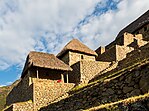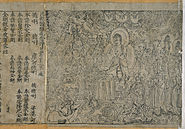Sejarah pascaklasik












Karya seni zaman pertengahan yang terkenal, masing-masing mewakili tamadun tertentu. Dari kiri ke kanan: Moai (Polynesia), Machu Picchu (Empayar Inca), topeng Pakal the Great (tamadun Maya), Book of Kells (Seni Insular), Notre-Dame de Paris (seni bina Gothic Perancis), Basilica San Vitale (seni bina Byzantine), Dome of the Rock (Zaman Keemasan Islam), Masjid Djinguereber (Empayar Mali), Gur-e-Amir (Empayar Timurid), Sutra Berlian (Dinasti Tang), Nataraja (Dinasti Chola), dan potret Jayavarman VII di Bayon (Empayar Khmer)
Dalam sejarah dunia, sejarah pasca klasik merujuk kepada tempoh dari kira-kira 500 CE hingga 1500 CE, kira-kira sepadan dengan Zaman Pertengahan Eropah. Zaman tersebut dicirikan oleh perluasan tamadun secara geografi dan perkembangan jaringan perdagangan antara tamadun.[1][2][3][A] Zaman ini juga dipanggil zaman pertengahan, zaman pasca purba, zaman pasca purba, zaman pra-moden, atau zaman pra-moden.
Nota penjelasan
- ^ Pascaklasik sering digunakan untuk menggambarkan sejarah global yang berlaku pada zaman Zaman Pertengahan Eropah (yang skopnya sepenuhnya berpusatkan Euro). Penggunaan Post-Classical sebagai istilah untuk tempoh itu kadangkala dipertikaikan tetapi masih digunakan dalam kalangan akademik.[4] Penggunaan 'Sejarah Dunia' Pascaklasik ini tidak boleh dikelirukan dengan tempoh Pascaklasik Mesoamerika.
References
Petikan
- ^ Kedar & Wiesner-Hanks 2015.
- ^ The Post‐Classical Era Diarkibkan 31 Oktober 2014 di Wayback Machine by Joel Hermansen
- ^ Ralat petik: Tag
<ref>tidak sah; tiada teks disediakan bagi rujukan yang bernamaweller-stearns - ^ "Cross-Cultural Interaction and Periodization in World History". The American Historical Review. 1996. doi:10.1086/ahr/101.3.749. ISSN 1937-5239.
Sumber
- Templat:Cite Cambridge History of China
- Allsen, Thomas T. (2001). Culture and Conquest in Mongol Eurasia. Cambridge: Cambridge University Press. ISBN 978-0-521-80335-9.
- Barraclough, Geoffrey (2003). HarperCollins Atlas of World History. Ann Arbor: Borders Press in association with HarperCollins. ISBN 978-0-681-50288-8. OCLC 56350180.
- Bauer, Susan Wise (2010). The History of the Medieval World: From the Conversion of Constantine to the First Crusade. New York: W. W. Norton & Company. ISBN 978-0-393-05975-5.
- Belich, James; Darwin, John; Frenz, Margret; Wickham, Chris, penyunting (2016). The Prospect of Global History. Oxford: Oxford University Press. doi:10.1093/acprof:oso/9780198732259.001.0001. ISBN 978-0-19-104613-1. OCLC 936040339. Diarkibkan daripada yang asal pada 18 October 2022. Dicapai pada 18 October 2022.
- Berger, Eugene; Israel, George; Miller, Charlotte; Parkinson, Brian; Reeves, Andrew; Williams, Nadejda (2016). World History: Cultures, States and Societies to 1500. Dahlonega: University of North Georgia Press. ISBN 978-1-940771-10-6. OCLC 961216293.
- Birken, Lawrence (1992). "What is Western Civilization?". The History Teacher. 25 (4): 451–461. doi:10.2307/494353. JSTOR 494353. S2CID 141243435. Diarkibkan daripada yang asal pada 1 April 2021. Dicapai pada 24 January 2020.
- Bowman, John S. (2000). Columbia Chronologies of Asian History and Culture. New York: Columbia University Press. ISBN 978-0-231-50004-3.
- Bulliet, Richard W.; Crossley, Pamela Kyle; Headrick, Daniel R.; Johnson, Steven Hirsch (2014). The Earth and Its Peoples: A Global History, Brief Edition. I: To 1550: A Global History. Boston: Cengage Learning. ISBN 978-1-305-14709-6.
- Christian, David (2000). "Silk Roads or Steppe Roads? The Silk Roads in World History". Journal of World History. 11 (1): 1–26. doi:10.1353/jwh.2000.0004. JSTOR 20078816. S2CID 18008906.
- Templat:Cite Cambridge History of China
- Haub, Carl (1995). "How Many People Have Ever Lived on Earth?". Population Today. 23 (2). Diarkibkan daripada yang asal pada 10 October 2016.
- Hermans, Erik, penyunting (2020). A Companion to the Global Early Middle Ages. Yorkshire: Arc Humanities Press. doi:10.2307/j.ctvz0h9cf. ISBN 978-1-942401-76-6. OCLC 1143847601. S2CID 241796784 Check
|s2cid=value (bantuan). - Holmes, Catherine; Standen, Naomi (November 2018). "Introduction: Towards a Global Middle Ages". Past & Present. 238 (13): 1–44. doi:10.1093/pastj/gty030.
- Kedar, Benjamin Z.; Wiesner-Hanks, Merry E., penyunting (2015). The Cambridge World History Expanding Webs of Exchange and Conflict, 500 CE–1500 CE. Cambridge: Cambridge University Press. ISBN 978-0-511-66748-0. OCLC 1058351091.
- Loud, G. A.; Staub, Martial, penyunting (2017). The Making of Medieval History. Woodbridge: York Medieval Press. ISBN 978-1-903153-70-3. OCLC 960462307.
- Masood, Ehsan (2009). Science and Islam: A History. London: Icon Books. ISBN 978-1-785-78202-2.
- Silverstein, Adam J. (2010). Islamic History: A Very Short Introduction. Oxford: Oxford University Press. ISBN 978-0-19-954572-8.
- Stearns, Peter N.; Adas, Michael; Schwartz, Stuart B.; Gilbert, Marc Jason (2011). World Civilizations: The Global Experience (ed. 6th). Upper Saddle River: Longman. ISBN 978-0-13-136020-4.
- Thompson, John M.; O'Toole, Dan; Patrick, Bethanne; Pruneski, Lauren; Thompson, Tiffin (2009). The Medieval World: An Illustrated Atlas. Washington: National Geographic Society. ISBN 978-1-4262-0533-0. Diarkibkan daripada yang asal pada 31 October 2021. Dicapai pada 19 November 2020.
- Vidal-Nanquet, Pierre (1987). The Harper Atlas of World History. New York: Harper & Row Publishers.
- Chronicle of World History. Old Saybrook: Konecky & Konecky. 2008. ISBN 978-1-56852-680-5. OCLC 298782520.
- Times Books (1998), Harper Collins Atlas of World History, New York: HarperCollins, ISBN 978-0-7230-1025-8, OCLC 41347894
Bacaan Lanjut
- Borgolte, Michael (2022). Die Welten des Mittelalters: Globalgeschichte eines Jahrtausends [The Worlds of the Middle Ages: Global History of a Millennium] (dalam bahasa Jerman). Munich: C.H. Beck. ISBN 978-3-406-78446-0.
Pautan luar
- Freemanpedia – a graphical representation of the Post-classical era.
- Silk Road Seattle – a rich selection of primary sources on the Silk Road and interactions between different cultures in Post-classical times.








